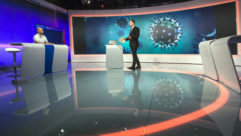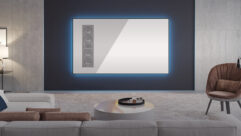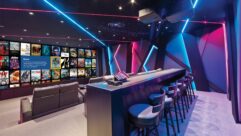Choosing the right rear-projection screen
May 20, 1997 12:00 PM,
Da-Lite Screen Company
The best projection equipment in the world won’t perform well if the screen is not right for the application.Buying the right projection equipment is simply not enough, especially today. To get the most out of today’s high standards of image quality, you need to match the right projection screen to your specific presentation media application. All too often, investments made in expensive A-V systems can result in less than expected image quality. In many instances, the reason can be traced back to an inappropriate screen selection. You can avoid such a disappointment and get optimum results from the equipment you have chosen with some simple up-front planning and careful attention to selecting the right rear-projection screen.
The selection process can be confusing. A wide range of rear-projection screen surfaces are available, each with different characteristics. You may ask, “What screen is best for my application, given the specific characteristics of the room and viewing area? With so many choices and options, where do I start?”
In this article, we will help you understand the requirements of your individual application and how to choose the appropriate rear-projection screen. (Note that this manual details alternatives for rear-projection screens only. If your application is better served by front-projection technology, refer to “Selecting Front-Projection Screens for Today’s Presentation Applications” in the August 1995 issue of S&VC, or contact Da-Lite for its selection manual.)
This process requires only three basic steps: One, define your presentation media application, then analyze the problems and situations identified with your application; two, complete the criteria checklist based on the specifics of your application, screen height, screen width, projection method, audience configuration, lighting conditions and screen construction; and finally, answer the questions in the decision matrix. This will lead you to the optimum screen choices for your application. That’s all there is to it.
Why rear projection?The use of rear-projection screens for visual presentations will benefit the audience in many ways:
* They don’t require “lights out” in the room.
* The projection beam can’t be blocked.
* They provide a professional “built-in” look.
* They enhance image contrast.
* Color and image uniformity are excellent.
* There is little projection noise.
* The only light reaching the back of the screen is the projection beam.
Primarily, a rear screen enables viewers to enjoy bright, legible images without having to turn room lighting off or down to the levels you need for front projection. Because the projector and all its hardware are installed behind the screen, presenters can’t block the projection beam. Such freedom makes viewing more comfortable and allows presenters to interact better with the audience and the subjects on the screen.
Total available floor space is important because you must have enough room behind the screen for a projection booth. New construction allows one to easily plan for this requirement, but in an existing room, it becomes a consideration. If the space allocated for the projection booth isn’t deep enough to allow the chosen projector to fill the screen, a special rack containing one or two projection-grade mirrors, such as Da-Lite’s Uni-Theater, can be installed to “fold” the projection beam so that it can travel its complete throw distance even in the smaller space.
To choose the right rear-projection screen, you must look at several considerations that affect the perception and quality of a presentation. We call these presentation media applications. Today’s typical presentation media applications fall into five distinct classifications: business-boardroom, business-classroom, home theater and entertainment, command and control, and teleconferencing. If your particular application is not described here exactly, you may find similarities in the problems and special situations identified in other applications as a helpful guide to making the most of the selection criteria list. Choose the application that best describes your situation.
Business-boardroom style meetingThe cornerstone of business is the meeting. Without meetings, vital information is not communicated effectively, which results in a quick paralysis of the organization. The better the ability to communicate clearly, quickly and effectively, the better the results.
This application includes any meeting where analysis and discussion of visual materials projected on a screen are required. You will find a wide variety of room configurations. Generally, if the room has already been constructed for rear-projection capabilities, it should be ideal for presentation purposes, and will usually be specifically designed for presentations. Lighting and seating arrangements can be controlled, and the screen size will vary according to the specific room size and number of participants. The range of projection methods is varied and can include, either singly or in combination, video and slide projectors.
Satisfying the requirements of this application isn’t particularly difficult. Multiple projection sources may be used on a single screen, which would require a screen that meets the needs of each without compromising the image quality of any. Variations in image brightness are expected when one projection source is changed for another. Finally, the nearest viewers are sometimes seated closer to the screen than is optimally recommended. If this situation is not corrected, it will dramatically exaggerate the viewing angle for some audience members.
Business-classroom trainingThis classic application is a key communication method in today’s hectic business world. Applications include any setting where a medium size group of people is seated before an instructor who is using presentation media as the focal point for communicating ideas and information. The advantage is that communicating effectively in mass enables companies to get employees up to speed quickly. Likewise, in the educational setting, educators are finding that an emphasis on visual communication is not only preferred by students but is far more effective in sharing information and concepts. An additional advantage is that rear projection allows presenters and their students the freedom to interact in light levels that make note taking easy.
Although business and educational settings are sometimes worlds apart, their presentation media characteristics and problems are common. Generally, participants take notes and refer to printed reference materials requiring near normal ambient light. Interaction and eye contact between the instructor and the class is vital for teaching and maintaining audience interest.
Meeting these requirements will require the solution of certain problems. Lighting conditions may not always be controllable to the extent desired, and in both the educational and business training areas, rooms may be multipurpose and have windows that cannot be fully shaded. Some presentations that may require note taking or reference to materials will dictate higher ambient room lights. The presentation might require a wide angle view, depending on audience configuration, for both horizontal and vertical viewing. A variety of projection methods, i.e. slides or video, may be used on the same screen.
Home theater-entertainmentThis growing application brings the realism of the movie theater right into the home. Whether an entire room is converted into an actual home “theater” or, more typically, a home entertainment system is used to show big screen video, movies and television, home owners are able to achieve professional quality results.
This application typically has used a CRT video projector in conjunction with a surround sound audio system, although the less expensive, though currently lower powered LCD projectors are increasingly more popular. The application objective is to attain the highest degree of visual and audio realism. The desire is to make the audio-visual experience as close as possible to the feelings experienced at a modern day cinema.
Typically, you’ll find that most home theaters have one or more of the following conditions:
* Lighting conditions may not always be fully controllable. For example, windows, skylights and entry ways can allow stray or direct light into the room, negatively affecting image contrast.
* The viewing area of the projection screen will be low in home theater settings.
* Wider screens will be required for HDTV and Letterbox formats.
Command and controlAlthough information displays used in a command-and-control environment can be useful and highly effective, in this application more than any other, specifying the right screen is critical. Command-and-control systems are used in plants or facilities that coordinate a number of different locations or operations, including such critical applications as a railroad switching center, a pipeline control monitor, or numerous military operations facilities.
In this application you’ll find command-and-control centers with elaborate rear-projection systems specifically designed from the ground up to handle the precise display requirements of each installation. Typically, you will find small numbers of seated or, in some cases, standing audience members or operators in a room configuration that dictates a wide viewing angle. Computer-generated imagery will be displayed on a large screen, enabling more than one person or station to view the same information simultaneously. Graphic displays will generally be involved, although actual video footage in real time might also be used (e.g. security monitoring). A larger rear-projection screen and a number of video projectors could be used, with the screen divided into different sections to create a seamless videowall.
This application offers specific challenges:
* The audience configuration is often dictated by factors that have nothing to do with ideal viewing angles.
* Data displayed on the principle screen or screens can be extremely critical and must therefore be presented in sufficient resolution to be instantly recognizable.
* The performance of essential tasks other than looking at the screen can require higher than average ambient light.
* The scope of the data being analyzed and the number of required operators often mandate the use of several large rear-projection screens. The configuration of these multiple screen displays is sometimes flat, but more often the screens are set at a slight angle to one another.
TeleconferencingDisplays used for teleconferencing applications are among the latest innovations in our electronic age. This technology allows people located in widely separate global locations to see, hear and communicate with one another as if they were all in the same room.
Rear-projection screens are judged essential for teleconferencing because each location in the teleconference is a transmitter as well as a receiver. Therefore, room lighting must be high enough for the pickup camera to transmit images that are bright enough to be clearly discerned by all the receiving groups.
In this application you will normally find a pair of side-by-side screens (one for output and one for input) with a small local audience arrayed directly before them. Rooms dedicated to teleconferencing will frequently include full TV studio lighting systems, which generally necessitate the use of special, high-gain, narrow viewing angle rear-projection screens. In addition to cameras focused on the participants, document cameras are frequently included in teleconferencing networks. These enable legible transmission of printed materials and text from one station to another. Because of the cameras and lighting considerations, audience configurations are usually restricted. High ambient light in the teleconferencing center must be assumed.
Selecting the right screenSix basic criteria should be considered when one selects a rear-projection screen. Each criterion accents key characteristics that a screen must possess to meet the various application objectives. These criteria are:
* Criterion 1 — Screen height: Because it’s important that the materials projected on your screen be legible for all viewers in your audience, choosing a screen size that is not too small is essential. The easiest way to begin calculating the right screen size is to take the distance from the screen to your last row of seats and divide it by eight. The number you get is a good approximation of the appropriate height of your screen.
* Criterion 2 — Screen aspect ratio (width): Once the height of your screen has been established, the correct width is easily found by determining which of the chosen projection sources has the widest aspect ratio. When the height of an image projected by that source equals your screen height, then screen width must be the same as that image’s width. Ideally the first row of seats should not be closer to the screen than two of its widths.
In virtually all commercial installations, the screen should be installed such that its bottom edge is at least 48 inches (1.2 m) above the floor. This will ensure that lower portions of the screen will remain visible from the rear of the audience. In home theater installations, the screen is normally installed only 25 to 32 inches (635 mm to 813 mm) above the floor.
In describing the size of a rear-projection screen, it is important to distinguish between the screen’s full, outside dimensions and its viewing area. Hence, a screen with a specified viewing area can have one set of outside dimensions if it’s framed and another set if it’s unframed. In both cases, however, the viewing area doesn’t change.
* Criterion 3 — Projection method: Determine the principal projection method to be employed. If multiple projection methods are to be used, determine which one will demand most from the screen and use that as your selection criterion. For example, in the case of an application that requires a rear-projection screen to display both LCD video and slides, use LCD as the selection method because of its lower brightness output.
For video projection, you have three basic technologies to worry about: light valve, CRT and LCD. Light valve technology is a video projection system that generally uses a high-power xenon arc lamp to produce up to 7,000 lumens. The image is projected through a single, interchangeable lens for variable throw distances. CRT technology is a common video projection system that creates imagery with three separate cathode ray tubes (one for red, one for green and one for blue), which are then projected through three separate lenses. These three-gun projectors produce between 600 and 1,600 lumens. Convergence of the three tubes is critical for best resolution and color rendition. LCD technology is the newest, using a conventional light source, usually a halide arc lamp, to project an image by passing light through three internal liquid crystal displays, one each for the colors red, green and blue. Each color is then combined through a series of mirrors into a single image. LCD projectors have lower resolution than CRTs and currently produce lower light levels (600 lumens maximum).
For slide projection, you have just 35 mm transparencies, one of the most popular methods of displaying single-frame photography. As with other portable film projection methods, the slides’ continuous tone properties and the pro-jector’s high light output (varying from 1,000 to 6,000 lumens) provide an excellent image while preserving fine detail and exceptional color rendition.
* Criterion 4 — audience configuration: Determine whether the seating area will require audience members to view the projected image from an angle of more than 30ø from either side of the screen’s center. If the room configuration forces some viewers to look at the screen from an angle greater than 30ø, a screen with extra-wide viewing angles is required. This can happen when the screen is set into a long wall instead of a short one.
* Criterion 5 — ambient light conditions: Determine whether light conditions are controllable to minimize light incident to the screen’s front surface. Controlled lighting ensures that no substantial amount of stray light is permitted to strike the screen. As a rule, a projected image should be at least five times brighter than anything else in the audience’s field of view.
* Criterion 6 — screen substrate: Rear-projection screens are manufactured from two types of substrates: glass and acrylic. Da-Lite’s acrylic version, Da-Plex, is available for any size up to 99×169. Da-Lite’s glass version, Da-Glas, is available in any size up to 109×209. (Da-Glas can be special ordered in larger sizes.)
Using the decision matrixNow you can use all of the information you have gathered about an application to choose the proper rear-projection screen using the decision matrix. To select the right screen, check YES or NO to each question asked and follow the appropriate line to the question below until you reach the recommendation.
The type of screen you choose can be broken down into the following:
* A: Choose a diffusion screen with a neutral gray color to provide contrast. Uniformity and color rendition are important for high-resolution application. (The Da-Lite example would be the DA-WA N, with a screen gain of 1.0 and a 65ø field of view.)
* B: Choose a screen specifically coated for video projection under controlled light conditions. Field of view should be especially wide so each seat in the audience observes a uniform, bright, sharp image with no color shift. (Da-Lite’s example is the Video Vision, with a 1.0 gain and 110ø field of view.)
* C: Choose a neutral white diffusion screen with wide off-axis viewing for controlled or low ambient light conditions. (Da-Lite’s example is the DA-WA, with a 60ø field of view and 1.5 gain.)
* D: Choose a neutral gray diffusion screen designed for multi-image displays where bend angles from some of the images may be severe. A wide seating arrangement must be accommodated. (Da-Lite’s example is the DA-1N, with a gain of 1.8 and a 50ø field of view.)
* E: Choose a screen that strikes a balance between gain and viewing angle. The screen must handle situations where a high level of ambient light would be a problem for lower-gain screen surfaces. (Da-Lite’s example is the DA-3N, with a 2.3 gain and a 40ø field of view.)
* F: Choose a high-gain screen that delivers an extremely bright diffused image for very narrow viewing applications, especially those that use low-powered projection sources. (Da-Lite’s example is the DA-5N, with a 5.0 gain and a 30ø field of view.)
* G: Choose a lenticulated screen with a high, uniform gain. (Da-Lite’s Mark 30 has an on-axis gain of 2 with a 120ø horizontal and 20ø vertical field of view. Resolution is preserved down to 4 lines per millimeter. Available in sizes up to 109×169.)
* H: Choose a lenticulated screen combined with a Fresnel lens for use in situations where the brightness from a single projection source is low. (Da-Lite’s example is the Pollens, which combines a large Fresnel lens with a panel of vertical lenticulations. Center gain is 3, which is distributed over a 100ø horizontal and 20øvertical field of view.)
* I: Choose a Fresnel screen designed for single image display. (Da-Lite’s DA-View has a 4 gain and a 50ø horizontal and 10ø vertical field of view.)
* Diffusion screens: These screens have an extremely fine, precise optical coating applied to a transparent glass or acrylic substrate.
* Profiled screens: Unlike diffusion screens, which have a smooth surface, lenticulated or profiled screens have grooves physically cut into one or more surfaces. When these grooves are a series of fine vertical ribs, they are called lenticulations. These lenses work to distribute energy from the projector across a wide horizontal viewing cone.
* Fresnel-type display screens: These screens feature a lens on their back surface, which is formed by a series of concentric circular grooves, each cut at a different angle. Working together, all of these grooves reduce the incident angles of light rays from the projector so that more of their brightness is available for transmission directly to the audience. Fresnel lenses are almost invariably used in conjunction with lenticulations; the reverse, however, is not true.
Ambient light: All light in a viewing room produced by sources other than the screen.
Aspect ratio: The numeric relationship between a screen’s height and width. This ratio is often defined by the selected projection medium. For example, NTSC images have an aspect ratio of 3:4.
Bend angle: The angle between the line of sight and the direction of a ray of light from the projector through a point on the screen.
Brightness: A viewer’s subjective response to luminance.
Contrast ratio: The numeric relationship between the brightest and the darkest portions of a display expressed in foot lamberts as a ratio of max:min.
CRT: Cathode ray tube. Also known as three-gun. Used with two-piece projection and direct view monitors and television.
Diffusion: A coating applied to a transparent substrate in sufficient density to exhibit a projected image.
Dispersion: The degree to which a screen scatters the light it transmits from a projector.
Field of View: an area in front of a screen in which all members of the audience seeking acceptable viewing conditions should be positioned. Measured in degrees from screen center, a field of view is conical in shape and enlarges as the distance straight back from the screen is increased.
Foot-candle: The fundamental unit of illumination representing the light intensity over a 1 ft2 surface that is 1 foot away from a standard candle.
Foot lambert (ftL): Unit of luminance equivalent to 1 lumen per square foot.
Fresnel lens: A device made by cutting a large number of closely spaced concentric circles into one surface of a sheet of acrylic, which can reduce the incident bend angles of light rays emanating from a projection source placed behind it.
Gain: A measurement usually made perpendicular to the screen center of the luminance transmitted by a screen, divided by the luminance radiating from the projector.
Half angle: The number of degrees a viewer needs to move away from the perpendicular before the observed gain is reduced by 50%.
HDTV: Acronym for high-definition television.
LCD: Liquid crystal display. A digitized display consisting of a pixelized image that is projected.
Lenticulation: A cylindrical lens that causes light rays passing through it to be dispersed perpendicular to its axis. A large series of parallel lenticulations is often cut vertically into a screen surface to improve its horizontal dispersion.
Light valve: A video projection system generally using a high-power xenon arc lamp to project a bright (up to 7,000 lumens) video image by using an electron beam to scan and construct the image.
Lumen: Quantity of visible light energy falling on 1 ft2 of the surface of a hollow sphere of 1 foot radius that has at its center a light source of one standard candle.
Lux: Quantity of visible light equal to 1 lumen per square meter.
Luminance: Measured brightness of the screen. Luminance is expressed in foot lamberts (inch-pound units) or millilamberts (SI unit). Brightness is the perceived light; luminance is the measured quantity.
NTSC: Acronym for National Television Standards Committee.
Projection axis: The direction of an imaginary line extending from the center of the projection lens through the screen’s center.
Resolution: The limit of a display’s ability to present distinguishable fine detail. Resolution is often expressed as the number of parallel lines that can be differentiated in a millimeter of screen surface.
Throw distance: The length of the projection beam necessary for a particular projector to produce an image of a specified size.
Uniformity: The absence of discontinuity between the brightness measurement at a screen’s center and the brightness measured at its corners and edges.
VGA: Video graphic array. Common computer resolution standard.
Viewing angle: The angle from a line perpendicular with the screen, measured horizontally or vertically from the line of sight.










